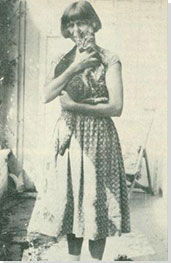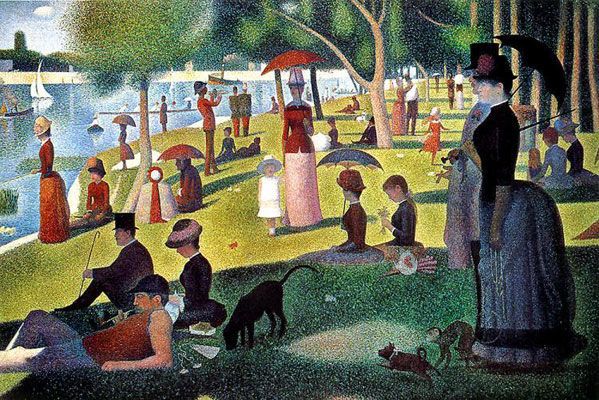Summary of Dora Carrington
Dora Carrington's impressive body of work is often overshadowed by the fiery dramas of her personal and romantic life. Indeed it can be difficult to ignore her many unconventional romances, her ambiguous sexual identity, and the dramatic suicide that ended her life when she was only thirty-eight years old. But looking beyond her sensational biography and carefully examining her work - which took the form of both painting and decorative arts - reveals an artist with a singular perspective. She was an artist who did not allow herself to be hemmed in by the trends of contemporary art. Instead, Carrington brought a unique blend of styles to her work, drawing from movements as disparate as Impressionism, Primitivism, and Surrealism. Most of her paintings are landscapes and portraits, and her sensitive rendering of her subjects reveals an artist with a keen eye who made an unrivalled contribution to European art of the early-20th century.
Accomplishments
- Working in a variety of styles, Carrington defied the artistic conventions of her contemporaries. Regardless of the style she worked in, a certain psychological depth was always there. From the penetrating intimacy of her portraits to the symbolism and mystery of her landscapes, emotional depth was a hallmark of her work.
- Carrington was virtually unknown for her art during her own lifetime and seems to have received little encouragement from her peers to exhibit her work. It was not until the latter half of the 20th century that her work received widespread recognition.
- Although her work does not overtly address feminism or women's issues, both Carrington's lack of critical recognition and her interest in "feminine" subjects - landscapes of her home, decorative arts, portraits of personal acquaintances - subtly reveal the perspectives of women in early-20th-century Europe, especially the struggles of women artists working in that context.
Important Art by Dora Carrington
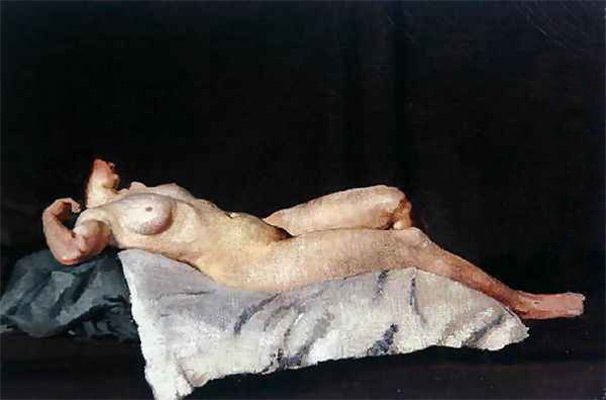
Female Figure Lying On Her Back
Carrington painted this nude during her time as a student at the Slade School for Art in London. She entered the painting in a university contest, claimed second prize, and won a two-year scholarship to continue her education. Carrington would go on to claim first prize in the same contest the following year. Slade was the first school in Britain to allow female students to use nude models for painting, albeit with restrictions. Male and female students sketched models in separate rooms, and male models for female students were partially covered for the sake of modesty.
This nude is rendered in the style of the Old Masters; the pale female form at the center of the canvas stands out against the dark background. The model's head turns away from the viewer, giving her anonymity and keeping the soft curves of her body the primary focus of attention. The painting is remarkably sophisticated and accomplished for an early, student work, in its attentiveness to subtle variations in skin tone, and the careful attention to light and shadow. The model's torso, right arm, and legs convey a kind of feminine softness, though other elements of the painting are somewhat less precise and polished. The blankets, along with the model's right foot, for example, have a more improvisational and loosely sketched quality.
This early painting stands out among Carrington's works in that it consciously imitates the established style of the historic female nude. As she developed as an artist, Carrington would deliberately distance herself from the historic and contemporary art styles, seeking to develop her own distinctive, personal, and autobiographical style.
Oil on Canvas - University College London Art Museum
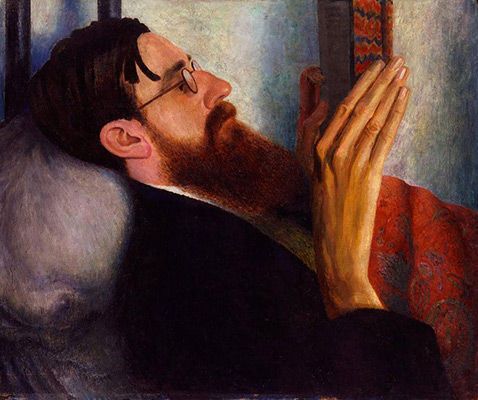
Lytton Strachey
Lytton Strachey was the great love of Carrington's life. It should not be surprising, then, that her portrait of him reveals especial depth and intimacy. The portrait casts Strachey in a fond, flattering light, intently reading a book in bed. His long hands and bushy reddish-brown beard stand out as prominent features. At the time Carrington painted this portrait, Strachey was working on Eminent Victorians (1918), a four-part biography of leading figures from the era, a work that would establish his enduring reputation as an important historical biographer.
The detail and emotional honesty of the painting speaks to the influence of the Pre-Raphaelites, who were concerned with expressing genuine ideas in a heartfelt, personal manner, while paying careful attention to detail, using the rich color palettes of early Renaissance painting. Carrington draws from this tradition here, but the soft light and loose brushwork also suggest some influence of the Post-Impressionist movement. Post-Impressionist work had attracted the attention of some members of the Bloomsbury Group, including art critic Roger Fry and novelist Virginia Woolf. Carrington's portrait of Strachey was painted during the First World War, but its gentle, peaceful mood is worlds away from the fear and anxiety of war. It does, however, subtly suggest the stylistic shifts of the evolving world of modern art. Through its bringing together old and new styles, it anticipates - if only faintly - the dramatic shifts on the horizon for the modern art world.
Oil on Panel - National Portrait Gallery, London
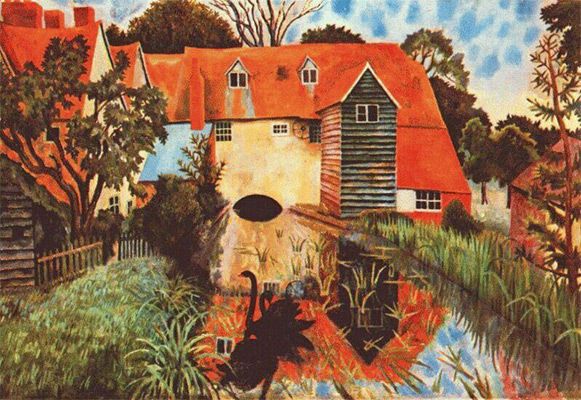
The Mill at Tidmarsh
This painting depicts the quaint home in the English countryside shared by Carrington and Lytton Strachey from 1917 to 1924. Carrington depicts a tranquil, but lively scene. The house - which was central to Carrington's personal life - takes up most of the canvas, leaving little room for the pastoral fields, water, and trees of the surrounding landscape. Carrington's vibrant orange roof contrasts with the vivid greens of the overgrown grass and hedges and blue sky, creating both harmony and dynamism.
The influence of the Pre-Raphaelites is evident in this work's loving attention to the natural world and its beautiful simplicity. The Pre-Raphaelites were followers of the cultural critic John Ruskin, whose writings encouraged artists to return to nature, "rejecting nothing, selecting nothing, and scorning nothing." His philosophy is at play in Carrington's painting, since the natural world is a vital, active component of her work; it is far more than mere background. Still, Carrington's loving focus on the quirks of her home suggests that she also had her own agenda.
Although Carrington is often lumped in with the Bloomsbury set, this painting reminds us of her independence from the group. Carrington lived in a world of her own, which was a respite from the gray stones and close-packed buildings of London. While many of the Bloomsbury artists were drawn to the experimentalism and iconoclasm popular in the modern art movements of the 1910s, Carrington's early paintings are somewhat ahead of their time in that they reveal a certain nostalgia for a threatened, vanishing English way of life. These sentiments are most commonly associated with the art being produced in Europe in the years just before the Second World War.
Oil on Canvas - Private Collection
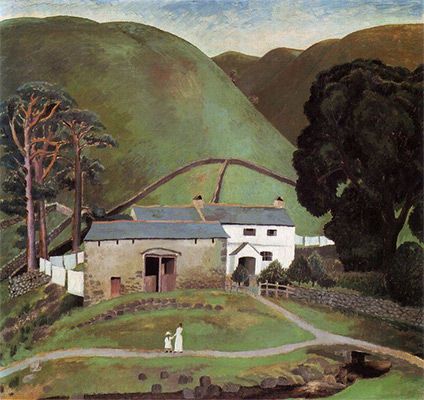
Farm at Watendlath
During the late 1910s and early 1920s, Carrington's subjects were mostly intimate portraits and landscapes. This painting depicts Watendlath Farm, near Keswick in the Lake District of England, where she spent a summer holiday with her husband and their friends in 1921. It was during this trip that Carrington met the writer Gerald Brenan, who became one of her lovers. Thus, the trip was especially meaningful for Carrington, suggesting the poignancy of this painting.
As in Carrington's other landscape paintings, the image of this small, verdant farm immediately creates a sense of intimacy, and even of pleasant escapism. The identities of the woman and the child dressed in white are not known. Throughout her work Carrington depicted women of different ages, in what seem to be meditations on femininity and what it means to be a woman. Scholars have argued that the two female figures in this image, who are dwarfed by a fertile and hilly landscape, could serve a metaphorical purpose. Just like these small, vulnerable figures who are lost in their large landscape, Carrington was an artist who was overwhelmed by her own struggle with her identity as a woman and artist in early the early-20th century. This interpretation is plausible, given Carrington's fraught relationship with the social norms of her time.
Oil on Canvas - Collection of the Tate, United Kingdom
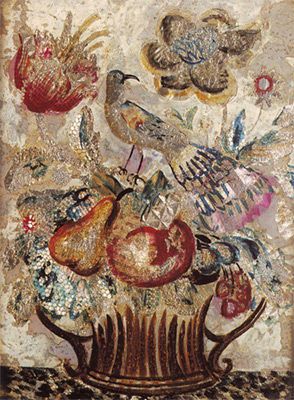
Rouen Ware
This unique, colorful depiction of fruits, flowers, and a brightly plumed bird on a brass urn is one of what Carrington called her "tinseled pictures," which she often presented as gifts to friends. These were essentially collages on glass, which she created by outlining her overall design in black or deep blue ink on the back of the pane, and then filling in the outline with collage elements composed out of textured foil paper, and covered them with a blend of opaque and transparent paints. Art historian Jane Hill claims that the success of these pieces came from Carrington's intuitive understanding of "how much glass to leave uncovered and how much work the silver will do." The textured foil and the warm, metallic hues of the piece lend it a romantic, old-fashioned delicacy. Some elements of the composition, particularly the bird's tail and the red bloom at the top left, seem to have an almost mosaic quality. The unique technique reveals Carrington's ingenuity as an artist and her willingness to combine old traditions with new ones.
In addition to these works in foil and glass, Carrington also completed a number of impressive domestic art pieces for her friends and intimates, including fireplace tiles, frescoes, signs for inns and pubs, and an intricately decorated gramophone for the Strachey family. Though many of these pieces are sadly lost to history, those that remain have gained considerable attention in recent years from Carrington scholars, who argue these pieces are a testament to the broad range and skill of this long underappreciated artist.
Oil, Ink, and Silver Foil on Glas
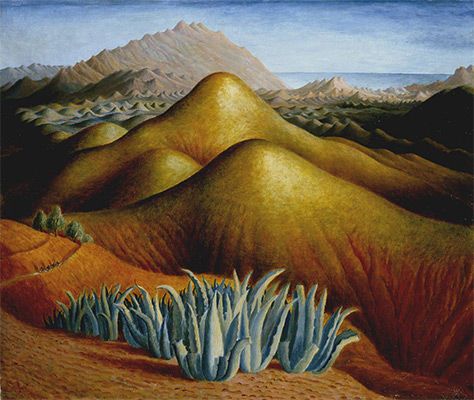
Spanish Landscape with Mountains
Carrington traveled in Spain in 1924, visiting the Andalusia region, which was the inspiration for this painting. She spent much of her visit in the town of Yegen, where her friend and occasional lover Gerald Brenan was living. When she returned home to Tidmarsh Hill, where she completed the painting, she wrote to Brenan, "I am working on the landscape you liked; the round mountains near the gorges. I am trying a new plan, an entire underpainting in brilliant colors, over which I shall glaze green and more transparent colors."
The unnaturally smooth, rolling hills in the foreground contrast with the jagged peaks of the Sierra Nevada mountains in the far distance, creating the impression of a surreal, alien landscape. This painting marks a stark contrast to Carrington's other landscapes, in which mellow greens, blues, and whites are the predominant colors. Those colors, of course, were a logical choice for her depictions of the English countryside. But here, she depicts the Andalusian landscape in vibrant oranges and yellows, as if using color to highlight the differences between her homeland and the more arid (though still verdant) landscape of southern Spain. Four mules and their guides can be seen travelling on a winding road in the distance, at the left side of the canvas. Again, Carrington has emphasized the tiny scale of human beings in relation to a powerful, perhaps overpowering, natural world. Indeed, the figures are so tiny as to barely be noticeable, which emphasizes the power and size of the hills and mountains through which these people travel. Carrington's otherworldly depiction of the terrain echoes the style of earlier British landscape artist, James Dickson Innes, who was famous for his mountain landscapes. Still, what is most striking about this particular work is its distinct distance from the modern, urban world. The absence of industrial, urban imagery is striking, and perhaps reveals Carrington's own desire to distance herself from the modern world.
Oil on Canvas - Collection of the Tate, United Kingdom
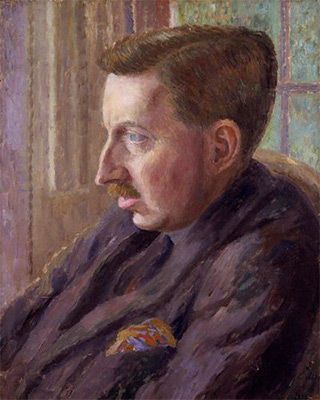
Portrait of E. M. Forster
This painting depicts Carrington's friend, the writer E. M. Forster. Much of his fiction critically examined British society, particularly the upper and middle classes. Surprisingly, given its careful attention to detail, the portrait was not painted with the benefit of a live sitting. Still, Carrington successfully captured something essential about her friend in the portrait. As the painter Henry Lamb said of the portrait, "I think there is something so very good about your head of Forster."
The painting differs slightly from Carrington's earlier portraits in that it uses a looser, more impressionist painting style. Given the fact that Forster's novels were known for their use of symbolism, it is unsurprising that Carrington's chose to work in an impressionist style rather than a realist one. The color palette is subdued, primarily comprised of peach, gray, and beige tones. Whereas her portrait of Strachey depicted the sitter as absorbed and fascinated, Forster seems pensive, even troubled. Carrington's ability to adjust her style to best convey the character of her sitters is evidence of her great artistic skill and sensitivity.
Oil on Canvas - National Portrait Gallery, London
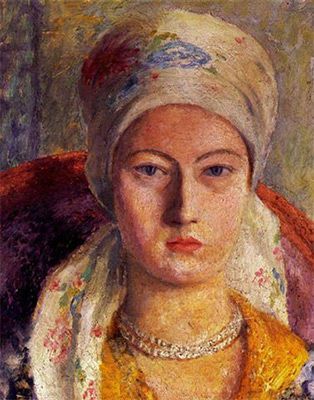
Julia Strachey
This portrait of Lytton Strachey's niece is painted in the same impressionistic style as Carrington's portrait of E. M. Forster, but the bold, vibrant color palette and golden light are typical of her some of her earlier portraits. Julia Strachey was a writer, and her guarded expression and steady gaze give the impression a woman with a clever wit and critical eye. The severity of Strachey's gaze is balanced by the softness and color of her clothing and accessories, providing a visual balance between strength and softness - between the intellectual and the worldly realms.
Carrington had known Strachey for many years at the time of this painting, having met her during the early years of her friendship with Lytton Strachey. The two women cultivated a close friendship, which provided Carrington with a confidante. Later, Carrington began to develop romantic feelings for Julia, writing to her in October 1929: "I wish I was a young man and not a hybrid monster, so that I could please you a little in some way, with my affection. You know you move me strangely. . . . You charm me so much." Julia was quite happily married, and the relationship Carrington hoped for never came to pass. Knowing Carrington's romantic feelings for Strachey, and that they remained unrequited may shed some light on this striking portrait, which is at once beautiful and austere.
Oil on Canvas - Private Collection
Biography of Dora Carrington
Childhood
Dora Carrington was the fourth of five children - the second of two daughters. Her parents were Samuel Carrington, a railway engineer, and his wife, Charlotte Houghton. Her earliest days were spent in Hereford, a short distance east of Wales. Several years later the family moved to Rothsay Gardens in Bedford.
Carrington would later recall that she had "an awful childhood." Her mother was anxious, demanding, and extremely pious, devoting much of her time to religious causes.
It was away from her family, at Bedford High School, that Carrington received personal attention that encouraged her creativity. Her teachers quickly recognized her artistic talent. While still a young student, she twice won national prizes for figure drawing, at the tender ages of 12 and 13.
Early Training
In 1910, Carrington enrolled in the Slade School of Art, part of University College, London. While at Slade, Carrington developed close friendships with two girls, Dorothy Brett and Barbara Hiles. So close were the trio that Dorothy and Barbara followed Carrington's lead when she cut her long hair to a daring, short bob. This was especially daring since the flapper trend of the 1920s was still several years away. The three soon became known as the "Slade Cropheads." It was around this time that Carrington stopped using her first name, and came to be known by many of those closest to her simply as 'Carrington' for the remainder of her life.
During her years at Slade, Carrington was romantically pursued by two fellow students, Christopher Nevinson and Mark Gertler, but she never pursued a relationship with either suitor. Still, she did little to dissuade their affections, which resulted in a great deal of drama and heartache all around.
In spite of her daring fashion choices and tumultuous romances, Carrington's artistic development during this time was rather pedestrian. She was learning and working in very traditional styles.
Mature Period
After completing her training at Slade, Carrington worked making paintings and woodcuts for the Omega Workshops and the Hogarth Press, both creative businesses established by members of London's bohemian Bloomsbury Group, whose most famous members included the novelists Virginia Woolf and E.M. Forster, as well as the noted economist John Maynard Keynes. Though she was friendly with many members of the group and maintained a regular correspondence with Woolf, Carrington was more of a fringe player in Bloomsbury. While working at the Omega Workshops in 1916, she met the writer Lytton Strachey, who would be her main love over the course of her life. The two became fast friends and started living together in November 1917. Even though he was openly homosexual, Carrington had deep romantic feelings for him. Their enduring friendship had much in common with a marriage, but, for her part, Carrington also explored other romantic relationships with both men and women.
In 1918, Carrington's father died, leaving her a small inheritance that allowed her greater financial - and thus artistic - independence. Soon thereafter she met Ralph Partridge, a friend of her younger brother, who worked at the Hogarth Press with Leonard and Virginia Woolf. Marking the start of a strange love triangle, both Carrington and Strachey fell in love with Partridge, and he returned the affections of both. Partridge married Carrington in 1921, and Strachey paid for the wedding. The trio went on a honeymoon to Venice together. Strachey commented, "Everything is at sixes and sevens-ladies in love with buggers and buggers in love with womanizers, and the price of coal going up too. Where will it all end?" Back in England, Carrington divided her time between fulfilling the domestic chores of a wife and those of an artist. She painted on almost any medium she could find, including glass, signs, tile, and the walls of her friends' homes.
In 1924, Strachey purchased the lease to Ham Spray House near Hungerford in Wiltshire. Soon, the tight union of the trio began to dissolve. Partridge found a mistress in London, while Carrington began an affair with Partridge's friend Bernard Penrose. An unwanted pregnancy and abortion put a sad end to their relationship in 1928. Carrington never again had a romantic relationship with a man, turning her attention exclusively to women.
Late Period
In late 1931, Strachey became violently ill. Although doctors were unable to correctly diagnose the problem, it was later discovered that he had stomach cancer. Panicked by Strachey's sudden decline, Carrington attempted to asphyxiate herself in the garage, but Partridge rescued her. Strachey died shortly thereafter, in January 1932. After his death, Carrington wrote in her journal: "They say one should keep your standards & your values of life alive. But how can I when I only kept them for you. Everything was for you. I loved life just because you made it so perfect & now there is no one left to make jokes with or talk to... I see my paints, & think it is no use for Lytton will never see my pictures now, & I cry."
Two months later, Carrington shot herself. She was found before she succumbed to her injury, allowing her closest friends to say their goodbyes at her bedside in Ham Spray House. She was thirty-eight years old.
The Legacy of Dora Carrington
Carrington was immortalized in print by D.H. Lawrence (Women in Love - 1920) and Aldous Huxley (Crome Yellow - 1921), but she never achieved fame as an artist during her lifetime. This can be attributed the fact that she rarely exhibited, or even signed, her work, along with the fact that she was not working in the most current styles. For many years, her art was associated with the Bloomsbury Group due to her connection with Strachey, as well as her many romantic entanglements within that group. Still, she was not interested in the formal experimentation of modernism to the same extent as some of the group's most famous members, including Roger Fry and Virginia Woolf. Indeed, she is now celebrated for her many portraits and landscapes that defy easy classification, lying somewhere on the boundaries of the Post-Impressionist, Pre-Raphaelite, and Surrealist movements. She is also celebrated for her attention to the decorative arts, as well as to "feminine" interests, from her focus on women in her landscapes to her interest in the "feminine realm" of the decorative arts.
In the 1970s, when David Garnett published a selection of her letters and selections from her diary, Carrington's painting gained a new academic and popular following. Since then, her work has been acquired by the Tate Britain, and was also the subject of a major Barbican retrospective in 1995. Her intimate portraits of those closest to her influenced an eclectic group of artists, particularly portrait painters in the UK and the US, including Alice Neel, Tracey Emin, and Tom Phillips.
Influences and Connections

-
![Roger Fry]() Roger Fry
Roger Fry ![Clive Bell]() Clive Bell
Clive Bell
![Aldous Huxley]() Aldous Huxley
Aldous Huxley![D. H. Lawrence]() D. H. Lawrence
D. H. Lawrence
Useful Resources on Dora Carrington
- Love in Bloomsbury (2014)By Frances Partridge
- The Art of Youth: Crane, Carrington, Gershwin, and the Nature of First Acts (2013)By Nicholas Delbanco
- Carrington: A Life (1995)Our PickBy Gretchen Holbrook Gerzina
- Carrington: Letters and Extracts from Her Diaries (1970)Our PickBy Dora Carrington and David Garnett
 Ask The Art Story AI
Ask The Art Story AI